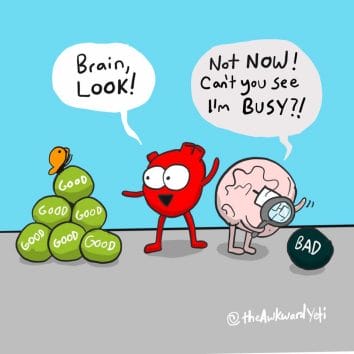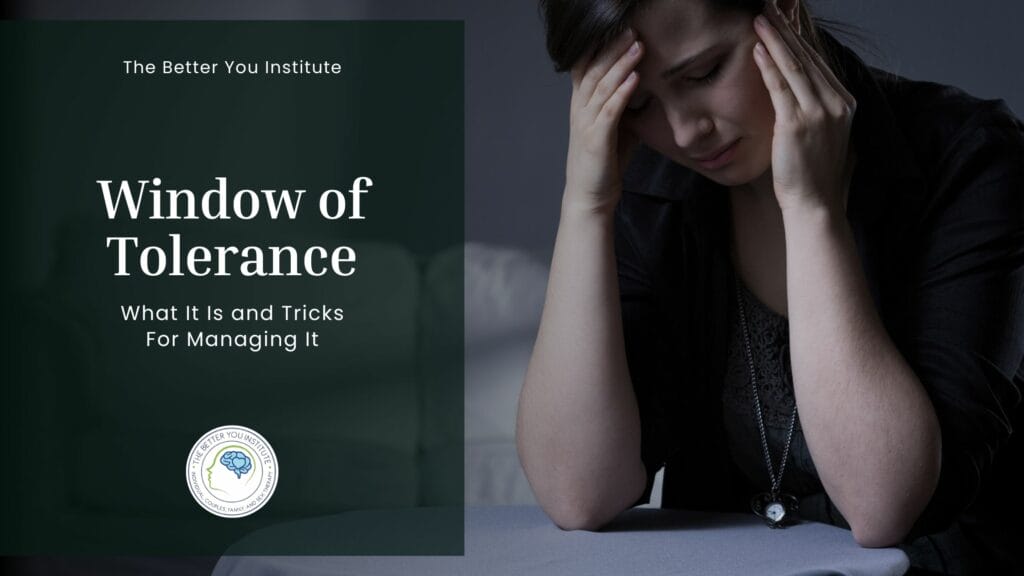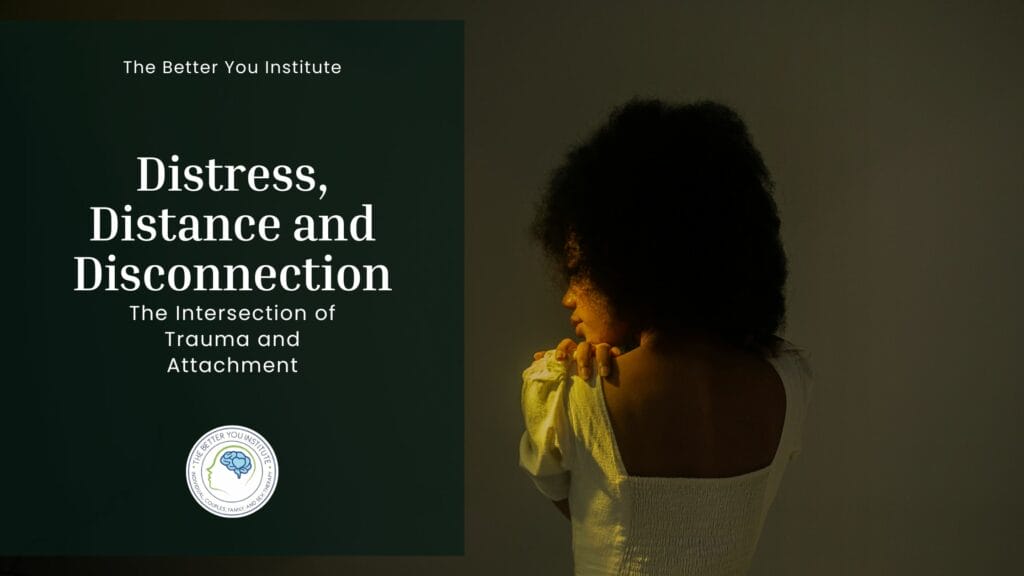Table of Contents
What Is The Negativity Bias?
The negativity bias is when we hold on to our negative thoughts instead of the positive ones. This bias makes our brain register negative stimuli quickly, and more easily and keeps us dwelling on these events. Yes, our negative thoughts stick with us longer than positive thoughts; it’s how our brains are wired!
Research shows that negative thoughts stick with us longer or in a more impactful way than positive thoughts. The negativity bias can cause us to dwell on something negative even when we have something that is equally or more positive in our life. The negativity bias causes a heightened emotional response to negative things and events compared to similar positive events. Think: fight, flight, or freeze response typically only happens when we feel we are in danger or when we perceive something negative is happening around us.
Some examples of the negative bias in action:
- When watching the news we tend to focus on the negative news versus the positive news the broadcasters present. Negative news coverage grabs the attention of viewers and readers. We become physiologically more activated when we hear negative news stories versus positive news stories.
- Experiencing negative feelings from criticism is stronger than happy feelings from compliments.
- Remembering one bad dish from the meal you had with friends when the entire cuisine tasted great.
- Never eating something again because you got sick from it one time, despite having the same meal several other times and not getting sick.
- Only seeing and judging a person for one bad quality instead of remembering and admiring the good ones.
- When you are in a depressed mood you search for negative things to confirm the negative emotions you feel.
- Receiving bad news makes us more alert because it draws our attention. We tend to have a more intense response to bad news rather than good news.
- Cringey moments can often get replayed in our minds. Even if the cringe moment happened years ago, our brains still find a way to replay the moment vividly.
- We tend to remember and replay the cringy and embarrassing moments even though others may not have any memory of the event.
Does Negativity Serve or Hinder Us?
If you find yourself feeling stuck thinking about negative things just know that it’s normal. Everyone experiences negative thinking at some point and sometimes it sticks longer than we want it to. When looking at reasons why the negativity bias serves us we can find a lot of explanations.
Dwelling on the negative and “bad stuff” is similar to the sensation of pain. Pain is present in our bodies to alert us. It acts almost as a safety mechanism to make changes to something we’re doing (e.g., take our hand off the hot stove or set boundaries with our friend who is a taker), and then protect injured areas until they have time to heal. Even though the feeling of pain is unpleasant, it serves the purpose to protect us from harm.
The negativity bias is similar to the sensation of pain because it is meant to protect us from current and future danger. However, we can start to see this bias hinder us in today’s age because most humans are no longer in immediate survival danger from their environment as frequently as we once were. We are starting to come to the realization through science and research that constant negative thoughts are harmful to our mental and physical health.
Why do we focus on the negative things?
When we look at our brains we can trace back the neurological roots of the negativity bias. During the beginning of evolution, the human brain was designed to protect us from harm. For example, over hundreds of millions of years, it was a matter of life and death to pay attention to certain survival tactics. The human brain served us because it made us become aware of our environment.
Research tells us that negative thinking has been developed by humans thousands of years ago. One theory for why this occurs stems from an evolutionary perspective where at one point in human existence, it was to our benefit to remember what was poisonous or dangerous (think, saber-toothed tigers!). The negativity bias is looked at as being a natural adaptive evolutionary function. Our brains being hardwired to remember negative things that existed in the world kept us alive.
Fortunately, we have found a way to conquer poisonous berries and saber-toothed tigers; unfortunately, our brains have not evolved in the same way technology has. Human beings use negative thinking to protect themselves from immediate environmental events and we have developed the negativity bias as a means for survival. When dissecting what goes into the negativity bias we can conclude that the bias serves us to protect us from immediate danger.
Early humans focused on the bad experiences because they used that information to learn for the next time. The bad experiences are almost always stronger than the good ones and that is because we learn from that information. The bad things in life (emotions, people, situations, feedback) have more of an impact than the good things. We become more motivated to avoid the bad things/situations because we don’t want to sit in discomfort.
Inattentional Blindness
Our focus on negative things is rooted in how our attention works. Psychologists Arien Mack and Irvin Rock pioneered the concept of inattentional blindness. This concept is our failure to notice a fully visible, but unexpected object because our attention was engaged on another task, event, or object. An example of this would be when you are driving and you think you are paying attention to the road, and you fail to notice a car swerving into your traffic lane.
Mack and Rock’s research tells us that while our brains might be processing the things our eyes see, the mind might never become aware of these things. The conscious mind holds what we are focused on and on what holds our attention. The negativity bias can also be looked at as a negative attention bias. When we put our attention or focus on negative things, we shift our perception into seeing negative things. By focusing our attention on the negative events in our lives, we can miss out on the positive events without even realizing it.
How Does Negative Thinking Impact Us?
The negativity bias can impact our mental and physical health. Negative thinking can cause us to experience and feel unwanted emotions. These emotions can influence our behaviors, actions, and attitudes. Some unwanted emotions include:
- Anger
- Emptiness
- Helplessness
- Guilt
- Shame
- Fear
- Failure
- Sadness
- Overwhelmed
- Inadequacy
- Annoyed
- Worried
- Hurt
- Unworthy
- Unloveable
- Not good enough
Our thoughts and emotions are connected to one another and they influence our behaviors. The way we think has power over our perception of the world around us. Viewing the world through a negative lens can leave lasting impacts on our mental and physical health. Negative thinking can generate the following issues:
- The inability to make decisions (i.e., decision paralysis)
- Diminishes the brain’s ability to think, reason, and form memories
- Digestive issues
- Emotional distress
- Muscle pain
- Headaches
- Growing sensitivity to stress
- Tendency towards pessimism
- Degenerative brain diseases
- Cardiovascular problems
- Increase anxiety and depression
- Damages immune system
- Depletes brain chemicals (serotonin & dopamine)
- Chronic physical illness(es)
- Increase worry and fear
- High blood pressure
- Creates chronic stress
- Increased levels of cortisol in the brain
- Chronic stress can decrease our lifespan
Cognitive Distortions
As life goes by we can find ourselves getting stuck in familiar thinking patterns. These negative thinking patterns people find themselves falling into have significant impacts on our behaviors, emotions, and perspective of the world. Within the Cognitive Behavioral Therapy model, these negative thinking patterns are also called cognitive distortions. These distortions are also known as cognitive errors, thinking mistakes, and thinking errors. The APA defines cognitive distortions as faulty or inaccurate thinking, perception, or belief.
Cognitive distortions are thinking traps that can take over your brain without your knowledge of the thoughts occurring. Moreover, these cognitive distortions feel real, which leads you to act or emote according to how you are perceiving things despite the potential of being stuck in a negativity bias.
Examples of common cognitive distortions:
- Black-and-white thinking
- When you only look at situations in terms of one extreme or the other. A situation is either a failure or a success, bad or good. There is no middle ground
- Catastrophizing
- This occurs when you imagine the worst thing possible is about to happen and predict that you won’t be able to cope with the worst-case scenario.
- Over-generalization
- You conclude that one negative event is actually part of a series of unending negative events
- Should Statements
- This takes place when you have set rules for how you, or others, should and shouldn’t behave
- Fortune-telling
- This occurs when you predict that things will turn out bad
- Filtering
- When you only pay attention to the negative aspects of a situation while ignoring all the positives.
- Personalization
- Believing that everything others do or say is some kind of direct, personal reaction to something you’ve said or done.
- Minimizing
- This happens when we lessen the importance of something significant.
- Ex: You lessen a personal achievement
- This happens when we lessen the importance of something significant.
- Maximizing
- This distortion happens when something negative happens and it is blown out of proportion
- Ex: A mistake is exaggerated
- This distortion happens when something negative happens and it is blown out of proportion
If you read a cognitive distortion that you resonated with, good, now you can use this awareness! These are some of the most common distortions and they are our minds’ way of convincing us of one thing when, if we really sat and looked at the evidence, we’d find that most of these thoughts are completely untrue or unfounded. These inaccurate thoughts are used to reinforce negative thinking patterns, which saved us at one time, and it can be easy for our minds to fall into this way of thinking.
Becoming aware of your negative thoughts in situations is the first step you need to take to create change. Making a conscious effort to pay attention to the negativity bias becoming activated is the first step to conquering unpleasant thinking patterns.
How to Overcome Negative Bias
There are multiple ways to overcome the negativity bias. If you are feeling stuck, worried, or frustrated just know that you are not alone. Negative thinking affects everyone at some point in their lives. Below you will find strategies to help you overcome negative thinking.
- Be aware of the negative bias
- Recognizing yourself having negative thoughts is the first step to overcoming the negativity bias.
- Practice self-compassion by giving yourself patience and grace.
- Re-frame the way you think
- Reframing is a technique used in Cognitive Behavioral Therapy (CBT). This technique identifies automatic thoughts and replaces them with more balanced thoughts.
- Practice noticing your cognitive distortions- every time you are experiencing a distortion point it out to yourself.
- Evaluate the evidence and think solely about the facts. Remove your thoughts and emotions from the situation.
- Gratitude Journal
- Practice grateful thinking. You can use a gratitude journal to keep track of the things you are grateful for. By practicing gratitude you are allowing positive emotions into your life. Training yourself to be grateful and focus on the good things will help you overcome the negativity bias.
- Check out this article on how to practice gratitude in everyday life here.
- Ask “what went well?” before analyzing
- When a situation occurs, take a moment to reflect on what went well. By training your brain to be mindful of the good things, you will start to change your perspective on situations. Approach this with kindness and curiosity.
- Read more grounding techniques.
- Repeat positive affirmations
- Affirmations have the ability to change our outlook on life. Affirmations provide great benefits and they can help control negative feelings. Affirmations fire up neural pathways and make changes to the areas of the brain that makes you feel happy and positive. Examples of affirmations include:
- I am strong
- I am confident
- I am enough
- I am worthy of love
- I believe in myself and my abilities
- Affirmations have the ability to change our outlook on life. Affirmations provide great benefits and they can help control negative feelings. Affirmations fire up neural pathways and make changes to the areas of the brain that makes you feel happy and positive. Examples of affirmations include:
Are you struggling with negative thoughts and negative bias?
Understanding our negative thoughts can improve our mental and physical health. It is normal to feel stuck, confused, or frustrated when dealing with bad thoughts. Being aware of these thoughts is the first step to take in overcoming them. Challenging these negative thoughts can help kickstart the growth process.
When we allow ourselves grace and kindness, we can be open to change. If you want to start learning how to overcome negative thoughts or have questions about starting the process, feel free to schedule an appointment at The Better You institute with one of our Philadelphia therapists. Call us today, at 267-495-4951 to set up your appointment.
Meet The Author:

Claire Savage, M.Ed
Professional Counselor
Claire Savage, M.Ed, a Professional Counselor and Practicum and Intern Liaison, is known for her caring and open-minded nature. Her background as a first-generation Irish American has shaped her focus on identity development in therapy, helping clients understand their passions, purpose, and values. Drawing from her Division I Rowing experience at Temple University, Claire emphasizes the importance of mental health and the role of failure in personal growth. She approaches therapy like a puzzle, using person-centered, experiential, somatic, emotionally focused, and cognitive behavioral approaches to help clients gain new perspectives and control over their lives. Claire holds a Bachelor’s and Master’s in Counseling Psychology from Temple University. Passionate about Philadelphia, she enjoys exploring coffee shops, attending workout classes, and spending time with loved ones. Claire is dedicated to guiding clients on their wellness journey.
Learn more about Claire Savage ⇒








